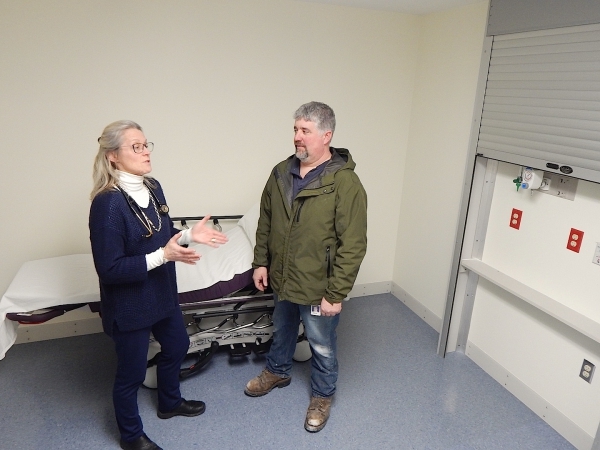TOWNSHEND — The newest room inside Grace Cottage Hospital's Emergency Department doesn't have a lot of high-tech bells and whistles.
But some of the space's most important features aren't easily spotted: There's a door that swings both ways; reinforced walls; a security camera connected to the nurses' station; and remotely activated electrical outlets.
It's all part of Grace Cottage's new “safe room,” a space designed to help the Townshend hospital deal with an increasing number of emergency patients struggling with mental health and/or addiction issues.
It's proof that Vermont's smallest hospital isn't immune to a problem that is plaguing health care providers statewide - a dearth of inpatient mental health beds that is forcing hospitals to provide extended emergency care to psychiatric patients.
“There's such a shortage ... and until they find that bed, they are stuck here in the emergency room,” said Dr. Kimona Alin, Grace Cottage's Emergency Department director.
Vermont officials have been struggling for years with providing the right kind and the right number of mental health treatment beds. The problem was exacerbated in 2011, when Tropical Storm Irene forced the closure of the Vermont State Hospital.
That led to an increasing issue with mental health patients waiting in hospital emergency rooms for an opening in a psychiatric care facility. The addition of inpatient beds at the Brattleboro Retreat and at the Vermont Psychiatric Care Hospital in Berlin has provided some relief, but it didn't solve the problem.
Safety concerns
Lengthy emergency room stays for those who need mental health treatment can lead to safety concerns, both for patients and for hospital staff. Locally, Brattleboro Memorial Hospital was cited by the state last year for issues involving two patients who had been unable to leave the hospital due to a lack of available psychiatric beds elsewhere.
With just 19 inpatient beds, Grace Cottage doesn't see the kind of traffic Brattleboro Memorial does. But the Grace Cottage Emergency Department still logs about 3,000 patient visits annually, and Alin said an increasing number of those patients have mental health issues.
Grace Cottage offers a host of mental health services, including a crisis team from Health Care and Rehabilitation Services of Vermont, short-term and long-term counselors, and a psychiatric nurse practitioner.
Those in need of inpatient mental health care, however, have to go elsewhere. And Alin said some patients have had to wait several days at Grace Cottage for such a placement, creating space and staffing pressures.
A traditional emergency or hospital inpatient room, Alin said, is not a good spot for mental health patients. “There are all sorts of utensils and sharp things and harmful things,” she said. “If they're truly suicidal, you cannot possibly keep them in a room like that safely.”
Hence the new “safe room” at Grace Cottage. Occupying the Emergency Department's former waiting room, which has been relocated, the safe room might be most notable for what it lacks - “anything that a patient might use as a weapon against themselves or others,” hospital administrators say.
But there are many safety-related details integrated into the room. For example, medical infrastructure like outlets, oxygen, and suction can be covered by a retractable, locking metal door.
Special baseboard material is secured so that it cannot be removed. Electrical outlets can be disabled remotely. And even the doorstop is anchored deep in the floor.
As for the entrance door, “it's heavy duty, and it swings from both sides,” said Scott Hitchcock, Grace Cottage's facilities director. The latter feature is important so that the door can't be barricaded from the inside.
Costly innovation
The room is small but didn't come cheaply, even with Hitchcock and his staff performing much of the work themselves. Grace Cottage raised $26,000 for the project, with $20,000 of that earmarked for the safe room and an additional $5,750 for a specially outfitted bed, said Andrea Seaton, director of the hospital's foundation office and community relations.
There are other potential uses for Grace Cottage's safe room: It's a place, for instance, “where you can bring family with a patient and be a bit more private,” Alin said.
But the space's primary purpose is for mental health patients who may pose a danger to themselves or others. And Grace Cottage isn't alone in creating such a space, said Judy Stermer, external affairs director for the Vermont Association of Hospitals and Health Systems.
Stermer said there are several other hospitals - including Porter Medical Center, Central Vermont Medical Center, Rutland Regional Medical Center and Brattleboro Memorial Hospital - that have created safe rooms or other spaces that can be tailored to serve mental health patients.
“It is something that we know is effective, and where possible, hospitals are looking to do this - because there's a real need, especially in emergency departments,” Stermer said.
But a safe room still isn't much more than a Band-Aid for the state's much larger mental health treatment issues.
To try and address some of those issues, Grace Cottage Chief Executive Officer Roger Allbee is advocating for more sustainable funding mechanisms and a more integrated health care approach. And he believes some of that integration already is happening at Grace Cottage.
As evidence, he pointed to the work of Ben Wright, a psychiatric nurse practitioner and a relatively recent addition to the staff. Wright said he's found “a really closely knit group of providers here,” and he sees his work as integral to the hospital's mission.
“If you're a primary care provider, you're in the business of mental health,” Wright said.
